PONTIAC PONTIAC 1996 Owners Manual
Manufacturer: PONTIAC, Model Year: 1996, Model line: PONTIAC, Model: PONTIAC PONTIAC 1996Pages: 370, PDF Size: 17.69 MB
Page 181 of 370
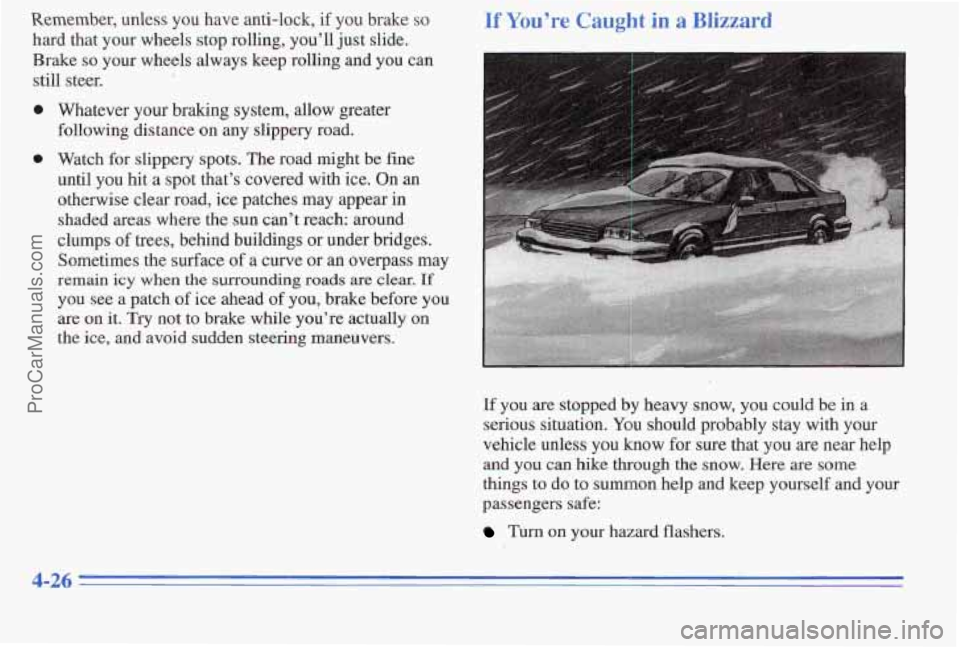
Remember, unless you have anti-lock, if you brake so
hard that your wheels stop rolling, you’ll just slide.
Brake
so your wheels always keep rolling and you can
still steer.
0 Whatever your braking system, allow greater
following distance on
any slippery road.
0 Watch for slippery spots. The road might be fine
until you hit a spot that’s covered with ice. On
an
otherwise clear road, ice patches may appear in
shaded areas where the
sun can’t reach: around
clumps
of trees, behind buildings or under bridges.
Sometimes the surface of a curve or an overpass may
remain icy when the surrounding roads are clear. If
you see a patch of ice ahead of you, brake before you
are on it. Try not to brake while you’re actually on
the ice, and avoid sudden steering maneuvers.
If You’re Caught in a Blizzard
If you are stopped by heavy snow, you could be in a
serious situation. You should probably stay with your
vehicle
unless you know for sure that you are near help
and
you can hike bough the mow. Here are some
things to do to summon help and keep yourself and your
passengers safe:
Ttim on your hazaid flashers.
4-26
ProCarManuals.com
Page 182 of 370
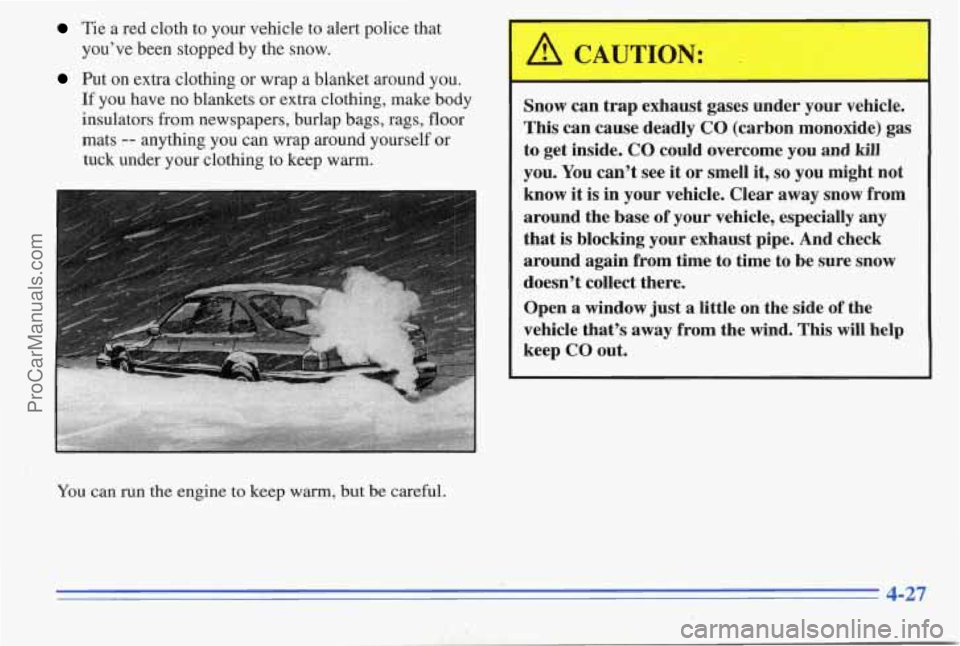
Tie a red cloth to your vehicle to alert police that
you’ve been stopped by the snow.
Put on extra clothing or wrap a blanket around you.
If you have no blankets or extra clothing, make body
insulators
from newspapers, burlap bags, rags, floor
mats
-- anything you can wrap around yourself or
tuck under your clothing to keep
warm.
You can run the engine to keep warm, but be careful.
A
I
/! CAUTION: -
Snow can trap exhaust gases under your vehicle.
This can cause deadly
CO (carbon monoxide) gas
to get inside.
CO could overcome you and kill
you. You can’t see it or smell it, so you might not
know
it is in your vehicle. Clear away snow from
around the base
of your vehicle, especially any
that
is blocking your exhaust pipe. And check
around again from time to time to be sure snow
doesn’t collect there.
Open
a window just a little on the side of the
vehicle that’s away from the wind.
This will help
keep
CO out.
4-27
1
ProCarManuals.com
Page 183 of 370

Run your engine only as long as you must. This saves
fuel. When you run the engine,.
make it go a little faster
than just idle. That is, push the accelerator slightly.
This
uses less fuel for the heat that you get and it keeps the
battery charged.
You will need a well-charged battery to
restart the vehicle, and possibly for signaling later on
with your headlamps. Let the heater
run for awhile.
Then, shut the engine
off and close the window almost
all the way to preserve the heat. Start the engine again
and repeat this only when you feel really uncomfortable
from the cold. But do it as little as possible. Preserve the
fuel as long as you can.
To help keep warm,'you can get
out of the vehicle and do some fairly vigorous exercises
every half hour or so until help comes.
.
Loading Your Vehicle
TI!RE-LBADING INFORMATION
VEHICLE
CAP. WT.
FRT, CTR. RR TOTAL LBS.
MAX. LOADING & GVWR SAME AS VEHICLE
CAPACITY
WEIGHT XXX COLD TIRE
TIRE SIZE SPEED PRESSURE
RTG ' PSI/KPa
FRT.
RR.
SPA.
IF TIRES ARE HOT, ADD 4PW28KPa
SEE OWNER'S MANUAL FOR ADDITIONAL
INFORMATION k
Two labels on your vehicle show how much weight it
may properly
carry, The Tire-Loading Information label
is
on the inside of the trunk lid. The label tells you the
proper size, speed rating and recommended inflation
pressures for the tires on your vehicle. It also gives you
important
irmformation about the numb'er of people that
can be
in your vehicle and the total weight you can
carry.
This weight is called' the vehicle capacity weight
and includes the weight
of all occupants, cargo and all
nonfactory-installed options.
ProCarManuals.com
Page 184 of 370
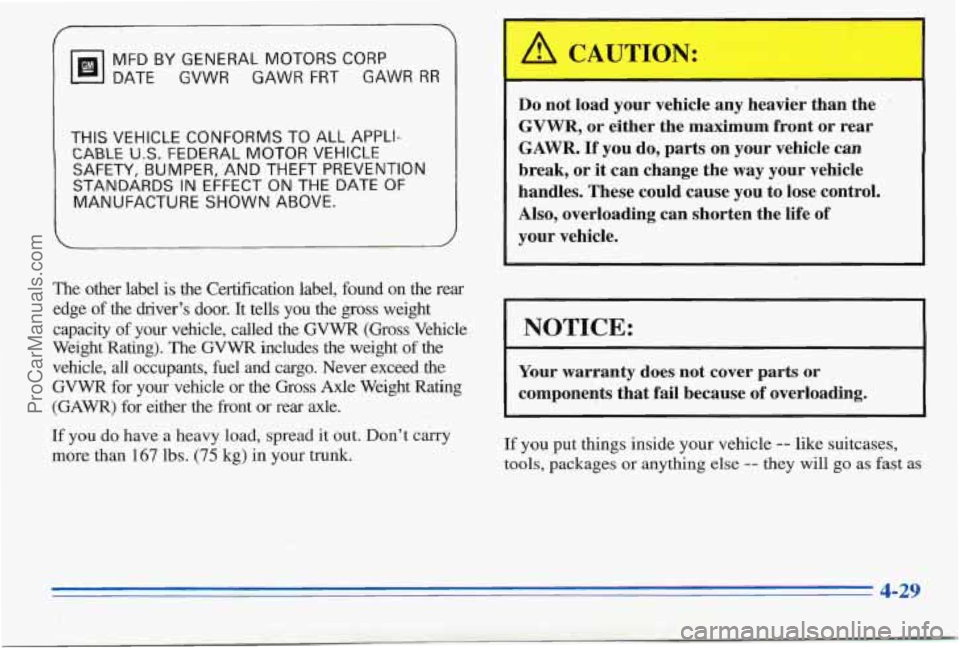
F
MFD BY GENERAL MOTORS CORP
DATE GVWR GAWR FRT GAWR RR
THIS VEHICLE CONFORMS TO ALL APPLI- .
CABLE U.S. FEDERAL MOTOR VEHICLE . .. '-" 1
SAFETY, BUMPER, AND THEFT PREVENTTON-
STAN.DARDS IN EFFECT ON THE DATE OF
MANUFACTURE SHOWN ABOVE.
The other label is the Certification label, found on the rear
edge of the driver's door. It tells you the
gross weight
capacity of your vehicle, called the GVWR (Gross Vehicle
Weight Rating). The
GVWR includes the weight of the
vehicle, all occupants, fuel
and cargo. Never exceed the
GVWR for your vehicle or the Gross Axle Weight Rating
(GAWR) for either the front or rear axle.
If you do have a heavy load, spread
it out. Don't carry
more than 167 lbs. (75 kg) in your trunk.
A CAUTION:
Do not load your vehicle any heavier than the -
GVWR, or either the maximum front or rear
GAWR.
If you do, parts on your vehicle can
break, or it can change the way your vehicle
handles. These could cause you to lose control.
Also, overloading can shorten the life of
your vehicle.
NOTICE:
Your warranty does not cover parts or
components that fail because of overloading.
If you put things inside your vehicle -- like suitcases,
tools, packages
or anything else -- they will go as fast as
I 4-29
ProCarManuals.com
Page 185 of 370
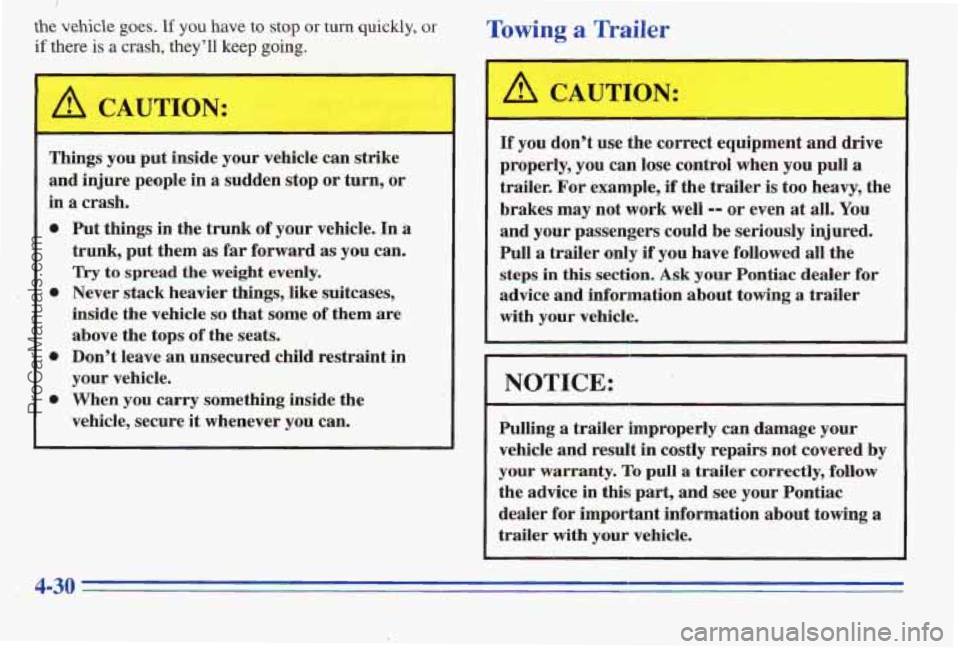
the vehicle goes. If you have to stop or turn quickly, or
if there is a crash, they’ll keep going.
Towing a Trailer
Things you put inside your vehicle can strike
and injure people in a sudden stop or turn, or
in a crash.
0 Put things in the trunk of your vehicle. In a
trunk, put them as far forward as you can.
Try to spread the weight evenly.
inside the vehicle
so that some of them are
above the tops
of the seats.
0 Don’t leave an unsecured chilb restraint in
your vehicle.
0 When you carry something inside the
vehicle, secure
it whenever you can.
0 Never’stack heavier things, like suitcases,
CAUTION:
If you don’t use the correct equipment and drive
properly, you can lose control when you pull
a
trailer. For example, if the trailer is too heavy, the
brakes may not work well
-- or even at all. You
and your passengers could be seriously injured.
Pull
a trailer only if you have followed all the
steps
in this section. Ask your Pontiac dealer for
advice and information about towing a trailer
with your vehicle.
NOTICE:
Pulling a trailer improperly can damage your
vehicle and result in costly repairs not covered
by
your warranty. To pull a trailer correctly, follow
the advice in this part, and see your Pontiac
dealer for important information about towing
a
trailer with your vehicle.
4130 -
ProCarManuals.com
Page 186 of 370
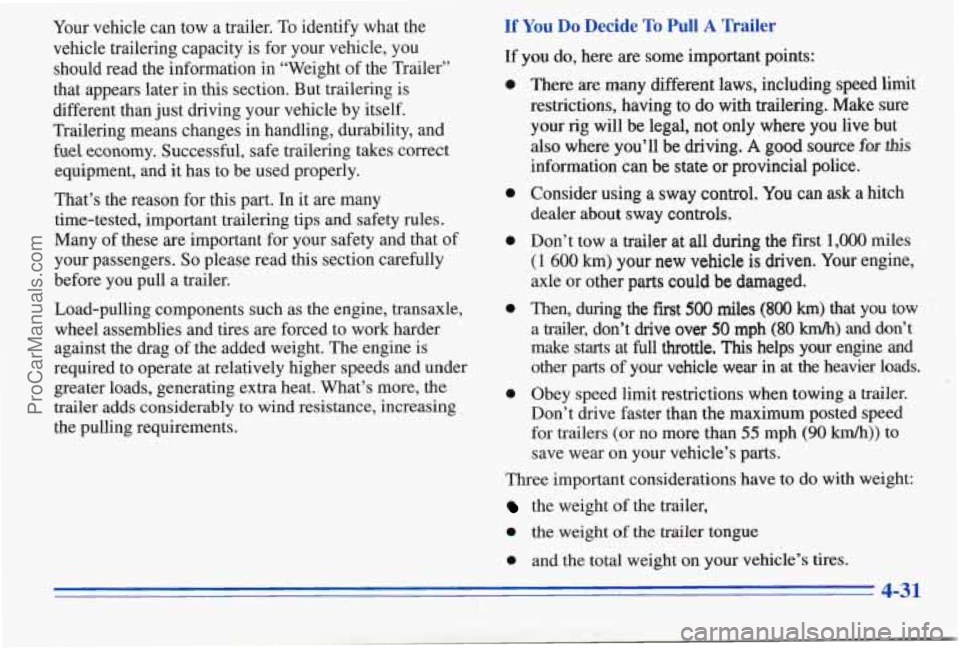
four vehicle can tow a trailer. To identify what the
vehicle trailering capacity is for your vehicle, you
should read the information
in “Weight of the Trailer”
that appears later in this section. But trailering is
different than just driving your vehicle by itself.
Trailering means changes in handling, durability, and
fwl economy. Successful, safe trailering takes correct
equipment, and
it has to be used properly.
That’s the reason for this part. In it are many
time-tested, important trailering tips and safety rules.
Many of these are important for your safety and that
of
your passengers. So please read this section carefully
before you pull
a trailer.
Load-pulling components such as the engine, transaxle,
wheel assemblies and tires are forced to work harder
against the drag
of the added weight. The engine is
required to operate at relatively higher speeds and under
greater loads, generating extra heat. What’s more, the
trailer adds considerably to wind resistance, increasing
the pulling requirements.
If You Do Decide To Pull A Trailer
If you do, here are some important points:
0
0
0
0
0
There are many different laws, including speed limit
restrictions, having
to do with trailering. Make sure
your rig will be legal, not only where you live but
also where you’ll be driving.
A good source fa this
information can be state or provincial police.
Consider using
a sway control. You can ask a hitch
dealer about sway controls.
Don’t tow a trailer
at all during the first 1,000 miles
(1 600 km) your new vehicle is driven. Your engine,
axle
or other parts could be damaged.
Then, during the
fkst 500 miles (800 km) that you tow
a trailer, don’t drive
over 50 mph (80 km/h) and don’t
make starts at
full throttle. This helps your engine and
other parts
of your vehicle wear in at the heavier loads.
Obey speed limit restrictions when towing a trailer.
Don’t drive faster than the maximum posted speed
for trailers (or no more than
55 mph (90 km/h)) to
save wear on your vehicle’s parts.
Three important considerations have to do with weight:
the weight of the trailer,
0 the weight of the trailer tongue
0 and the total weight on your vehicle’s tires.
4-31
ProCarManuals.com
Page 187 of 370
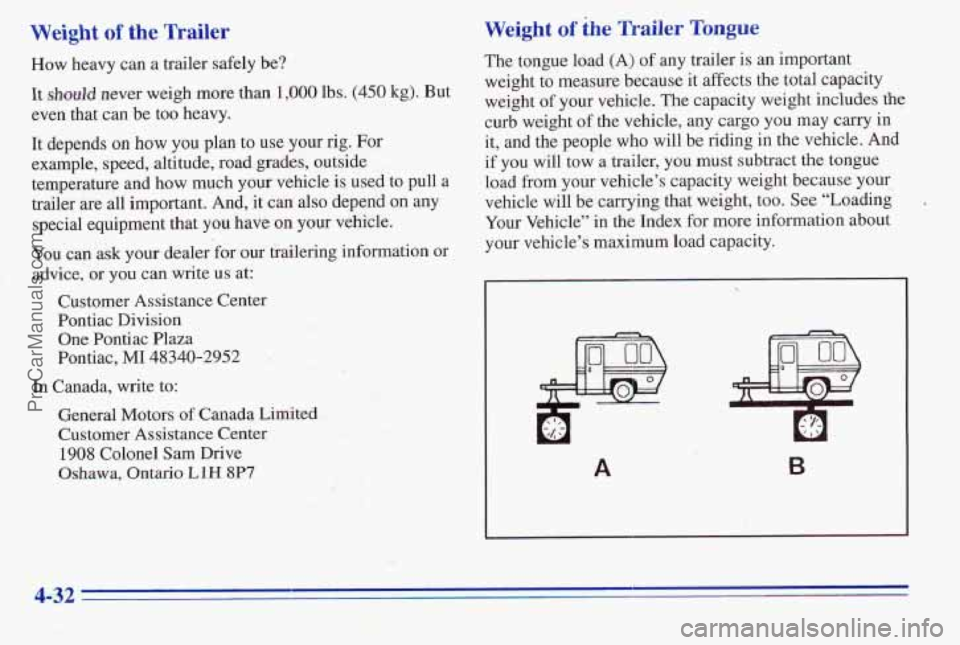
Weight of the Trailer
How heavy can a trailer safely be?
It should never weigh more than 1,000 lbs. (450’ kg). But
even that can be too heavy.
It depends
on how you plan to use your rig. For
example, speed, altitude, road grades, outside
temperature and how much
your vehicle is used to pull a
trailer are all important. And, it can also depend
on any
special equipment that you have on your vehicle.
You can ask your dealer ’for our trailering information or
advice,
or you can write us at:
Customer Assistance Center
Pontiac Division
One Pontiac Plaza
Pontiac,
MI 48340-2952
In Canada, write to:
General Motors
of Canada Limited
Customer Assistance Center 1908 Colonel Sam Drive
Oshawa, Ontario LlH 8P7
Weight of the Trailer Tongue
The tongue load (A) of any trailer is an important
weight to .measure bec.ause it affects the total capacity
weight
of your vehicle. The capacity weight includes the
curb weight of the vehicle, any cargo you may carry in
it, and the people
who will be riding in the vehicle. And
.if you will tow a trailer, you must subtract
the tongue
load
from your vehicle’s capacity weight because your
vehicle will be carrying that weight, too. See “Loading
Your Vehicle” in the Index for more information about
your vehcle’s maximum load capacity.
A B
4-32 -
ProCarManuals.com
Page 188 of 370
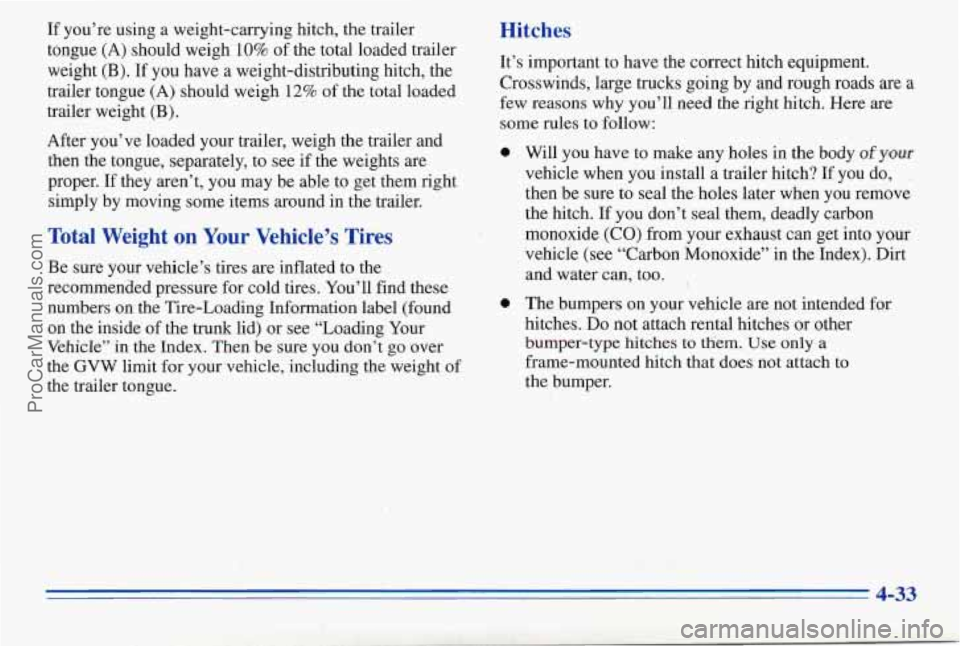
If you’re using a weight-carrying hitch, the trailer
tongue (A) should weigh
10% of the total loaded trailer
weight
(B). If you have a weight-distributing hitch, the
trailer tongue
(A) should weigh 12% of the total loaded
trailer weight (B).
After you’ve loaded your trailer, weigh
the trailer and
then &e tongue, separately, to see if the weights are
proper. If they aren’t, you may be able to get them right
simply by moving some items around in the trailer.
Total Weight on Your Vehicle’s Tires
Be sure your vehicle’s tires are inflated to the
recommended pressure for cold tires. You’ll find these
numbers on the Tire-Loading Information label (found
on the inside of the trunk
lid) or see “Loading Your
Vehicle” in the Index. Then be sure you don’t
go over
the GVW limit for your vehicle, including the weight of
the trailer tongue.
Hitches
It’s important to have the correct hitch equipment.
Crosswinds, large trucks going by and rough roads
are a
few reasons why you’ll need the right hitch. Here are
some rules to follow:
0
0 Will you have to make any holes in the body of your
vehicle when you install a trailer hitch? If you do,
then be sure to seal the holes later when you remove
the hitch. If
you don’t seal them, deadly carbon
monoxide
(CO) from your exhaust can get into your
vehicle (see “Carbon Monoxide” in the Index). Dirt
and water can, too.
The bumpers on your vehicle are not intended for
hitches.
Do not attach rental hitches or other
bumper-type hitches
to tlfem. Use only a
frame-mounted hitch that does not attach to
the bumper.
4-33
ProCarManuals.com
Page 189 of 370
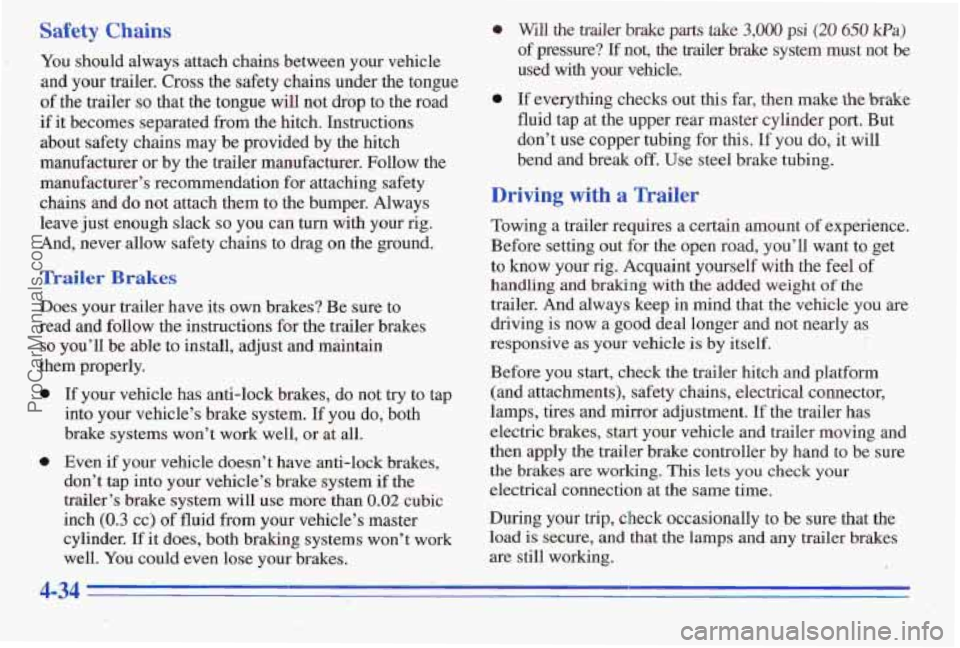
Safety Chains
You should always attach chains between your vehicle
and your
trailer. Cross the safety chains under the tongue
of the trailer so that the tongue will not drop to the road
if it becomes separated from the hitch. Instructions
about safety chains may be provided by the hitch
manufacturer
or by the trailer manufacturer. Follow the
manufacturer’s recommendition for attaching safety
chains and do not attach them to the bumper. Always
leave just enough slack’s0 you can
turn with your rig.
And, never allow safety chains to drag on the ground.
Trailer Brakes
Does your trailer have its own brakes? Be me to
read and follow the instructions for the trailer brakes
so you’ll be able to install, adjust and maintain
them properly.
0
0 If your vehicle has anti-lock brakes, do not try to tap
into your vehicle’s brake system.
If you do, both
brake systems won’t work well,
or at all.
Even if your vehicle doesn’t have anti-lock brakes,
don’t tap into
your vehicle’s brake system if the
trailer’s brake system will use more than
0.02 cubic
inch
(0.3 cc) of fluid from your vehicle’s master
cylinder.
If it does, both braking systems won’t work
well.
You could even lose your brakes.
0 Will the trailer brake parts take 3,000 psi (20 650 Pa)
of pressure?
If not, the trailer brake system must not be
used with
your vehicle.
0 If everything checks out this far, then make the brake
fluid tap at the upper rear master cylinder port. But
don’t use copper tubing for this.
If you do, it will
bend and break
off. Use steel brake tubing.
Driving with a Trailer
Towing a trailer requires a certain amount of experience.
Before setting out for the open road, you’ll want to get
to know your rig. Acquaint yourself with the feel of
handling and braking with the added weight of the
trailer. And always keep
in mind that the vehicle you are
driving is ~lolw
a good deal longer and not nearly as
responsive
as your vehicle is by itself.
Before you start, check the trailer hitch
and platform
(and attachments), safety chains, electrical connector,
lamps,
tires and mirror adjustment. I% the trailer has
electric brakes, start your vehicle and trailer moving and
then apply the traiEer brake controller by hand to be sure
the brakes are working.
This lets you check your
electrical connection at the Same time.
During your
hip, check occasionally to be sure that the
load
is secure, and that the lamps and any trailer brakes
are still working.
ProCarManuals.com
Page 190 of 370
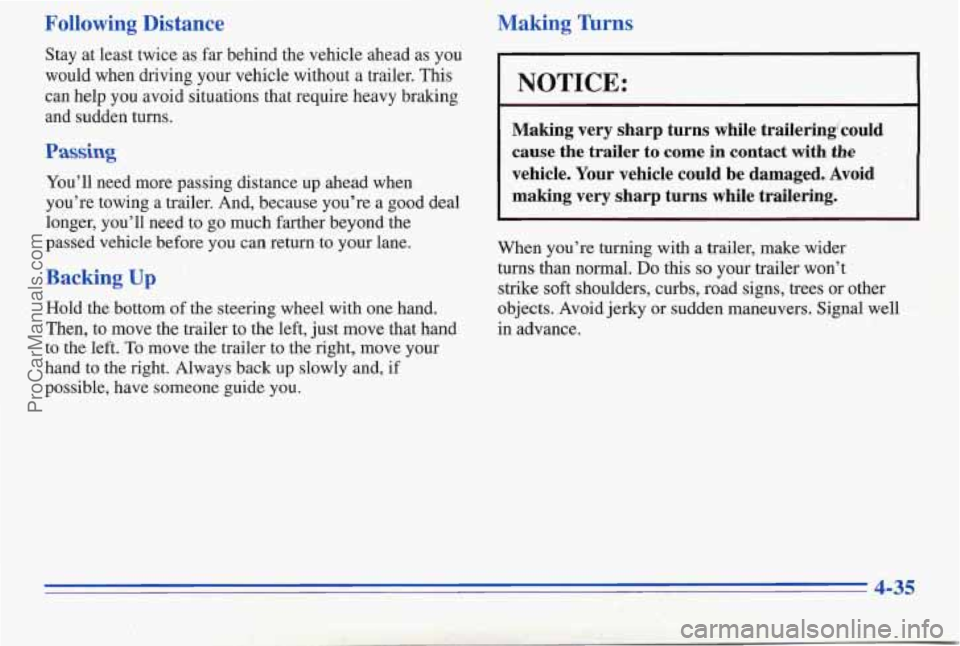
Following Distance
Stay at least twice as far behind the vehicle ahead as you
would when driving your vehicle without
a trailer. This
can help you avoid situations that require heavy braking
and sudden turns.
Passing
You'll need more passing distance up ahead when
you're towing a trailer. And, because you're a good deal
longer, you'll need to go much farther beyond the
passed vehicle before you can return .to your lane.
Backing Up L
- i -. ,. .. ,.
-'l, '' I. . '.:', .i Hold the bottom of the steering wheel with one hand.
' ' Then, to move the trailer to the left, just move that hand
to the left. To move the trailer to the right, move your
hand to the right. Always 'back up slowly and,
if
possible, have someone guide you.
Making 'hms
I
I NOTICE:
Making very sharp turns while trailering'could
cause the trailer to come
in contact with the
vehicle. Your vehicle could be damaged. Avoid
making very sharp turns while trailering.
When you're turning with a trailer, make wider
. . turns than normal. Do this so your trailer won't
strike soft shoulders, curbs, road signs, trees or other
objects. Avoid jerky or sudden maneuvers. Signal well
in advance.
ProCarManuals.com